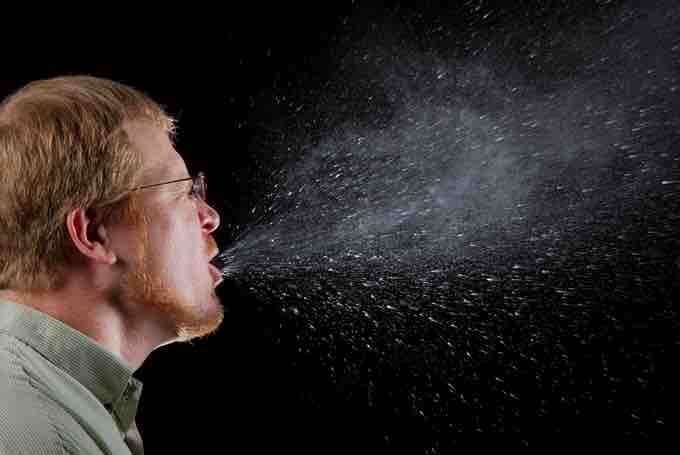Transmission is the passing of a communicable disease from an infected host individual or group to a conspecific individual or group by one or more of the following means: droplet contact, direct physical contact, indirect physical contact, airborne transmission, and fecal-oral transmission.
Transmission can also be indirect, via another organism. Indirect transmission could involve zoonoses or, more typically, larger pathogens like macroparasites with more complex life cycles. Disease can be directly transmitted in two ways. The first is horizontal disease transmission – from one individual to another in the same generation by either direct contact, or indirect contact air, such as via a cough or sneeze. The second is vertical disease transmission – passing a disease causing agent vertically from parent to offspring, such as through perinatal transmission.
Pathogens must have a way to be transmitted from one host to another to ensure their species' survival. Infectious agents are generally specialized for a particular method of transmission. For example, a virus or bacteria that causes its host to develop coughing and sneezing symptoms has a great survival advantage – it is much more likely to be ejected from one host and carried to another. This is also the reason that many microorganisms cause diarrhea.
The respiratory route is a typical mode of transmission among many infectious agents. If an infected person coughs or sneezes on another person, the microorganisms, suspended in warm, moist droplets, may enter the body through the nose, mouth, or eye surfaces. Diseases that are commonly spread by coughing or sneezing include: bacterial meningitis and chickenpox.

Sneezing
Sneezing can spread disease by launching disease vectors into the air.
When viruses are shed by an infected person through coughing or sneezing into the air, the mucus coating on the virus starts to evaporate. Once this mucus shell evaporates the remaining viron is called a droplet nucleus or quanta. The mucus evaporation rate is determined by the temperature and humidity inside the room. The lower the humidity, the quicker the mucus shell evaporates thus allowing the droplet nuclei to stay airborne and not drop to the ground. The low indoor humidity levels in wintertime buildings ensure that higher levels of droplet nuclei will survive: droplet nuclei are so microscopic that they are able to stay airborne indefinitely on the air currents present within indoor spaces. When an infected person coughs or sneezes, a percentage of their viruses will become droplet nuclei. If these droplet nuclei gain access to the eyes, nose, or mouth of an uninfected person (known as a susceptible) – either directly, or indirectly by touching a contaminated surface – then the droplet nuclei may penetrate into the deep recesses of their lungs. Viral diseases that are commonly spread by coughing or sneezing droplet nuclei include the common cold and influenza.
Direct fecal-oral transmission is rare for humans at least. More common are the indirect routes: foodstuffs or water become contaminated and the people who eat and drink them become infected. This is the typical mode of transmission for infectious agents such as cholera, hepatitis A, and polio.
Sexual transmission refers to any disease that can be caught during sexual activity with another person, including vaginal or anal sex or (less commonly) through oral sex. Transmission is either directly between surfaces in contact during intercourse or from secretions which carry infectious agents that get into the partner's blood stream through tiny tears in the penis, vagina, or rectum. Some diseases transmissible by the sexual route include: HIV/AIDS and chlamydia.
Sexually transmitted diseases such as HIV and Hepatitis B are thought to not normally be transmitted through mouth-to-mouth contact, although it is possible to transmit some STDs between the genitals and the mouth during oral sex. In the case of HIV this possibility has been established. It is also responsible for the increased incidence of herpes simplex virus 1 (which is usually responsible for oral infections) in genital infections and the increased incidence of the type 2 virus (more common genitally) in oral infections.
Diseases that can be transmitted by direct contact are called contagious. These diseases can also be transmitted by sharing a towel (where the towel is rubbed vigorously on both bodies) or items of clothing in close contact with the body (socks, for example) if they are not washed thoroughly between uses.